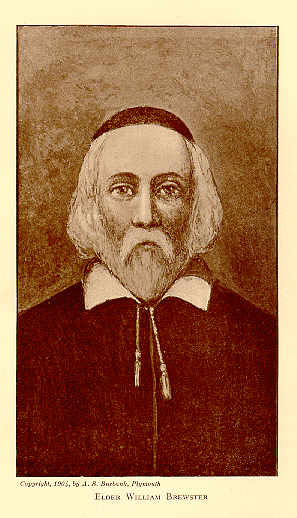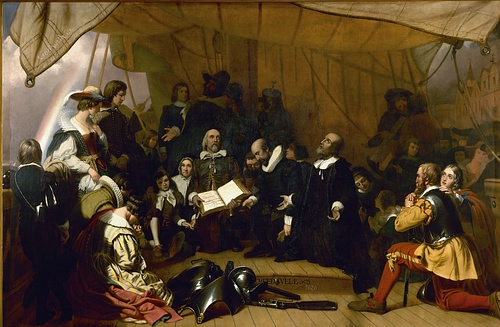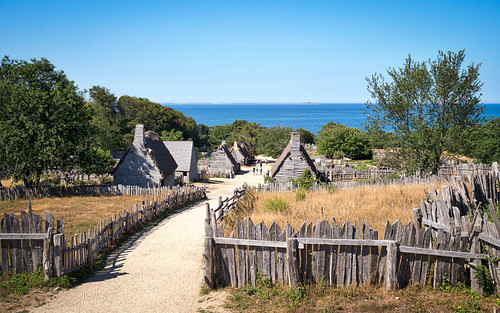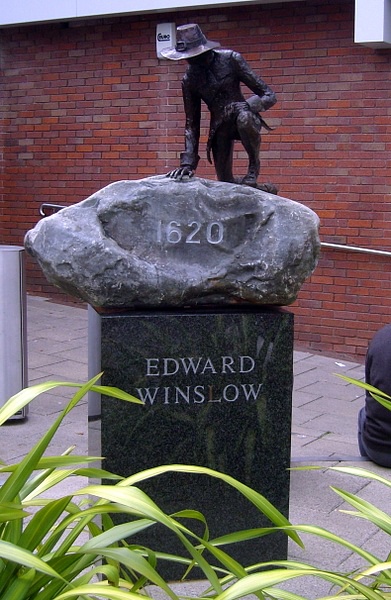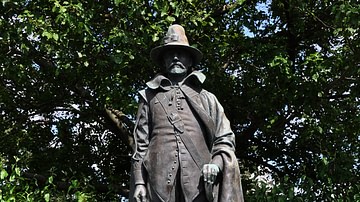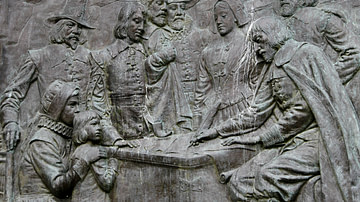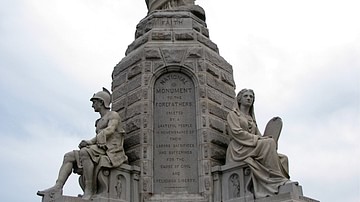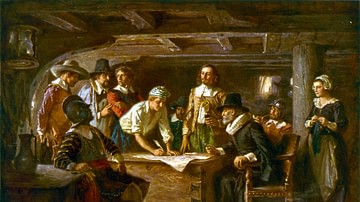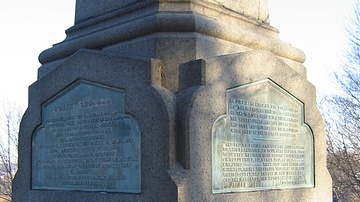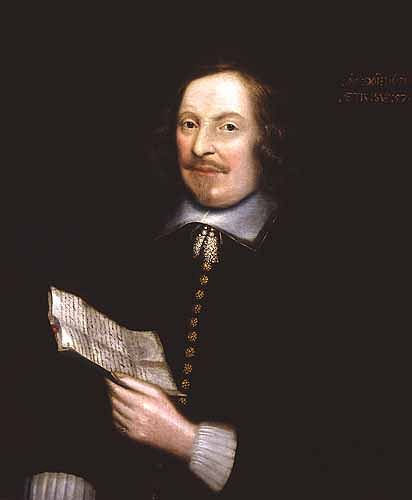
Edward Winslow (l. 1595-1655 CE) was a member of the separatist congregation (later known as pilgrims) which sailed aboard the Mayflower in 1620 CE to establish the Plymouth Colony in modern-day Massachusetts, USA. He became one of the more prominent citizens, negotiating the peace treaty with Wampanoag Confederacy (along with John Carver, l. 1584-1621 CE), healing their chief Massasoit (l. c. 1581-1661 CE) of a disease, serving as advisor to governors John Carver and William Bradford (l. 1590-1657 CE), and holding the position himself as well as later drafting the Articles of Confederation of New England, a precursor to the earliest version of the U.S. Constitution.
He is best known, however, for his written works chronicling the early years of the colony, Mourt's Relation (written with Bradford, published in 1622 CE) and Good News from New England (published 1624 CE) as well as other works published later. He is the only Mayflower passenger to have a portrait painted of him during his life, presently on exhibit in Pilgrim Hall Museum, Massachusetts, USA.
Winslow was among the more literate Mayflower passengers, well educated, and having served as an apprentice to the publisher John Beale of London. His written works show a clear command of narrative form, acquaintance with the genre of the travelogue and promotional guidebook (popular then among Europeans considering resettlement in the Americas) as well as literary, philosophical, and religious works. He is also notable for his understanding of the language of the Native Americans, describing and explaining a number of their words and concepts in his Good News.
During his time in Plymouth Colony, he served as governor three times, participated in the early exploration of the region, and was the chief diplomat to the Wampanoag Confederacy before returning to England in the 1640s CE. He died of fever while on an expedition to Jamaica in 1655 CE and was buried at sea, but his life and achievements have since been honored by monuments in Massachusetts, USA, and the continual interest in his written works, which are considered among the most important of Colonial America.
Early Life & Leiden Congregation
Winslow, the eldest of five boys, was born in Worcestershire, England in 1595 CE, to Edward Winslow, Sr. and his wife Magdalene. The family may have been upper-class and were among the more affluent of their community. Winslow's father worked in the salt trade and held the position of under-sheriff and, at the age of ten or eleven, Winslow was enrolled in King's School. The fact that the family could afford to have their eldest son educated rather than work is regularly cited as supporting the claim they were members of the upper class.
In 1613 CE, Winslow was apprenticed to the publisher John Beale of London. Scholar Kelly Wisecup comments on this period of his life:
After his formal education, Winslow worked as an apprentice in London for printer John Beale. In the course of this work, he would have encountered a variety of popular texts, including reports of the New World and its peoples. Beale printed many sermons and devotional guides as well as several plays, accounts of murders, and travel narratives or Guiana and Virginia during Winslow's apprenticeship…Winslow could thus have been familiar with traveler's descriptions of Native peoples' medicinal knowledge and expertise. (17-18)
England had been exploring the coast of North America by this time (c. 1613 CE) for decades and had, after a few failed attempts, had successfully founded the colony of Jamestown in Virginia in 1607 CE. Captain John Smith (l. 1580-1631 CE), one of Jamestown's founders, had extensively mapped the region of present-day New England and, as his works were quite popular, may have also been published by Beale and accessible by Winslow.
He was raised in the Anglican Church but embraced the Puritan-separatist vision of Christianity before he was 20 years old. Although the Anglican Church had been founded after breaking with Catholicism, it still retained a number of Catholic aspects, which Puritans objected to and wanted removed. Some Puritans (known as separatists) believed the church was too corrupt to be purified, however, and advocated the establishment of their own congregations, informed by the theology of the reformer John Calvin (l. 1509-1564 CE) and the former Anglican priest Robert Browne (l. 1550-1633 CE) who believed in a literal interpretation of the Bible as God's inerrant word.
King James I of England (r. 1603-1625 CE), as head of the Church, did not take this dissent lightly, and separatists were routinely persecuted for sedition since any criticism of the Church was regarded as treason. Even so, many separatist congregations sprang up throughout England, among them a small group in the village of Scrooby, which the writer William Brewster (l. 1568-1644 CE) belonged to. This group, persecuted in 1607 CE, fled to Leiden, the Netherlands, where the government held to a policy of religious tolerance.
It seems that Brewster contacted Winslow, while the latter was still apprenticed to Beale, for assistance in publishing anti-Anglican tracts and pamphlets. Winslow had been contracted to Beale for eight years but only served half that time before severing ties and joining Brewster's congregation in Leiden in 1617 CE, where he drew on his experience with Beale to publish Brewster's works. In 1618 CE, one of these anti-Anglican tracts drew the attention of King James I, who ordered Brewster's arrest.
The congregation had already initiated plans to found a colony in North America but now put more effort into the enterprise. A friend or member of the congregation purchased them a passenger ship, the Speedwell, and two of their members – Robert Cushman (l. 1577-1625 CE) and John Carver – negotiated with Thomas Weston (l. 1584 - c. 1647 CE), a so-called merchant adventurer who paired potential colonists with investors, for a cargo ship, the Mayflower, and the expedition was set to leave by mid-summer 1620 CE.
Mayflower Voyage & Compact
Winslow had married Elizabeth Barker (l. c. 1593 - winter of 1620/1621 CE), a member of the congregation, in 1618 CE, and the two left the Netherlands aboard the Speedwell to meet up with the Mayflower in Southampton. The original deal with Weston was for the congregation, alone, to sail to the New World aboard the Speedwell, with the Mayflower handling a few passengers but primarily serving to transport their possessions and provisions. Upon arriving at Southampton, however, they learned that Weston had changed the deal – and Cushman had agreed to it – now stipulating a number of people, not of their faith (referred to by the congregation as Strangers), would be accompanying them in order to ensure the success of the colony as a profitable venture.
The Speedwell, however, kept leaking, and they had to return to land twice for repairs before abandoning it. Some 20 passengers from the Speedwell then boarded the Mayflower, which, because of these delays, did not leave Plymouth, England, until 6 September 1620 CE, meaning they would be crossing the Atlantic during the rough weather of autumn seas and land in mid-fall instead of mid-summer.
Blown off course, the Mayflower landed off Massachusetts instead of their destination of Virginia, where English law had already been established, and once land was sighted, a number of the Strangers asserted their independence, pointing out that their patent was invalid in this region and they would live as they pleased as there was no law to control them. This dispute led to the composition of the Mayflower Compact, establishing a democratic form of government for the colony, which 41 of the men on board, including Winslow, signed in agreement.
Native Americans & First Thanksgiving
The Mayflower passengers had expected to land near an established colony where they could receive assistance if needed but were now forced to fend for themselves. Winslow took part in the early explorations of the area to determine a site for the colony between 11 November and 21 December 1620 CE when they chose an area previously inhabited by Native Americans which became Plymouth. During the first winter, 50% of the passengers and crew died of disease, malnutrition, exposure, and other causes, including Elizabeth Winslow. The settlers had no luck in planting crops and were still struggling in March of 1621 CE just to survive when they were approached by the Native American Samoset (also given as Somerset, l. c. 1590-1653 CE) who greeted them in English and would introduce them to others who would help the colony not only survive but flourish.
The two most significant were Tisquantum (better known as Squanto, l. c. 1585-1622 CE) and Ousamequin (better known by his title Massasoit, l. c. 1581-1661 CE) although Massasoit's right-hand man, Hobbamock (d. c. 1643 CE) would also play a significant role. Squanto had been kidnapped by the English years before and so knew the language and served as interpreter between the Native Americans and the colonists as well as teaching them how to grow crops, hunt, and fish. In March 1621 CE, he interpreted between Winslow, Carver, and Massasoit in forging a peace treaty which stipulated both parties would look out for each other's interests.
In May of 1621 CE, Winslow married the widow Susanna White whose husband William had died during the winter. Theirs was the first marriage of the colony, a civil ceremony conducted by Bradford, which would set the model for those which came after. Since the separatists rejected all religious traditions except their own, they maintained that any committed Christian in good standing with his congregation could officiate at weddings, funerals, and other events. The couple would have five children, though only two, Josiah (l. c. 1627-1680 CE) and Elizabeth (l. c. 1631-1698 CE), would survive to adulthood.
In autumn of 1621 CE, the colonists celebrated their survival with a harvest feast, commemorated in the United States since the 19th century CE as the holiday of Thanksgiving, which is recorded by Winslow first in Mourt's Relation. Contrary to the traditional depiction of the First Thanksgiving, there is nothing in the accounts of either Winslow or Bradford to suggest the Native Americans were invited to the feast. Both of these writers make clear that natives frequently visited the settlement for various reasons, and it seems likely this occasion followed that same model except that the natives stayed longer and participated in the festivities over three days.
Winslow became the primary liaison between the colonists and Massasoit and, in 1623 CE, when the great chief fell ill, Winslow traveled the 40 miles to his village with the intention of either paying his last respects or trying to help. Relying on Native American practices and his own medical knowledge, he not only saved Massasoit but nursed back to health a number of others who were stricken with the same disease. In gratitude, Massasoit bound himself more firmly to the colonists' cause, informing Winslow of a planned attack on the nearby settlement of Wessagusset and the Plymouth Colony, which resulted in the raid on Wessagusset by Captain Myles Standish (l. c. 1584-1656 CE) in which a number of Native Americans were killed.
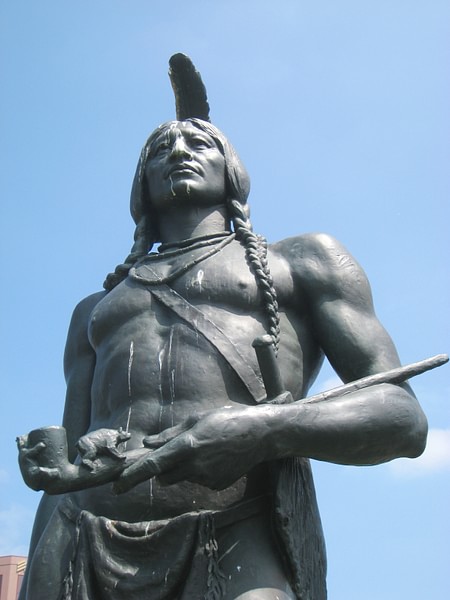
Mourt's Relation & Good News
John Carver had died, possibly of heatstroke, in April of 1621 CE, and Bradford became the second governor of the colony. Winslow was among his most trusted advisors and served as assistant governor. He would later serve as governor three times, taking over from Bradford for one-year periods in 1633, 1636, and 1644 CE and then handing the position back. In addition to these duties and others, Winslow was a prolific writer, composing two of the most important texts on the early years of the colony, Mourt's Relation and Good News from New England.
Mourt's Relation was written during the first year of the colony and the manuscript brought back to England by Robert Cushman in 1621 CE and published in 1622 CE with the original title of A Relation or Journal of the Beginning and Proceedings of the English Plantation Settled at Plimoth in New England, which became shortened to Mourt's Relation after the name of the publisher George Morton (also known as George Mourt, l. c. 1585-1624 CE) who contributed the introduction and may have edited and revised it.
The work consists of accounts by Winslow and Bradford along with letters by Cushman, Morton, and pastor John Robinson (l. 1576-1625 CE). It was the first work on the colony to appear in print, long before the better-known work Of Plymouth Plantation by Bradford. The purpose of publishing the booklet was to let people back in England know what the colony had endured upon arrival, how they had survived, and to encourage others to come to North America and establish their own settlements. The work covers the period from the pilgrims' departure from England to the First Thanksgiving of 1621 CE and Winslow would pick up from that point in his second book to carry the story further.
Winslow's Good News from New England is much more polished and, as the title suggests, was written to promote colonization of North America by presenting the land as one of endless opportunity and vast natural resources (a theme already developed in Mourt's Relation). His primary purpose in writing, however, seems to have been a defense of Standish's action at Wessagusset and the killing of the Native Americans without provocation. The pastor of the Leiden congregation, John Robinson, still in Holland, had condemned the attack when he read of it in one of Bradford's letters and Good News seems to have originally been an explanation and defense of the raid. Wisecup comments:
Winslow was an ideal candidate to write Plimoth's history and to defend the colonist's attack on the Massachusetts. As colonial diplomat and defender, Winslow combined an ongoing interest in and desire for information about New England Native peoples with a commitment to English colonization and colonial authority. Moreover, his education and livelihood before traveling to New England supplied him with experiences and knowledge that could have served as a foundation for his engagement with Native peoples. (17)
This work seems to have reached a larger audience than Mourt's Relation and served its purpose in bringing more English settlers to North America. The English editors minimized Winslow's account of the Wessagusset raid, however, moving it to the back of the book, to emphasize the appeal of the land of opportunity while downplaying any potential threats.
Conclusion
Although Winslow respected the Native Americans and their culture, he was an ardent advocate of colonization due to his belief in the Christian responsibility to share the gospel and convert the “unsaved”. He routinely depicts Massasoit and other Native Americans positively but never seems to regard them as the equals of white European Christians – particularly Protestant separatists whom he regarded as not only civilized but possessing the divine truth of the Christian vision. He makes this clear throughout his works, in the two addressed above as well as Hypocrisy Unmasked (1646 CE) and Glorious Progress of the Gospel Amongst the Indians of New England (1649 CE), the first an attack on one George Morton, whom he viewed as an agitator against the colony, and the second an account of successful missionary efforts to the Native Americans.
In 1643 CE, Winslow was one of the signers of the Articles of Confederation of the New England colonies, establishing the form of government that would serve as the basis for the earliest form of the United States Constitution drafted in 1781 CE. In 1646 CE, Winslow returned to England to promote Good News and advocate for further colonization and enlisted in the cause of the general and statesman Oliver Cromwell (l. 1599-1658 CE) who overthrew James I's successor, Charles I (r. 1625-1649 CE) to establish the puritanical Commonwealth of England. He continued to correspond with the Plymouth Colony but never returned, dying while on a mission for Cromwell to the Caribbean in 1655 CE.
His son, Josiah, became the 13th governor of the Plymouth Colony and also succeeded Myles Standish as commander of the militia. Under Josiah's tenure, the conflict known as King Philip's War (1675-1678 CE) broke out between the Native Americans and the English colonists who, by this time, had arrived in overwhelming numbers and were encroaching further and further on Native American lands.
The Wampanoag Confederacy at this time was led by Massasoit's son Metacom (also known as King Philip, l. 1638-1676 CE), who was opposed by, among others, Josiah Winslow, son of the man who had once saved his father's life. King Philip's War destroyed the relationship forged by the early colonists of Plymouth – as well as relations between Native Americans and colonists throughout New England – ending in defeat for the natives and the death or enslavement of many of them.
It has been suggested by modern-day historians that Josiah Winslow reversed any advances in relations between colonists and Native Americans secured by his father through his policies, but these were influenced by Winslow's vision of the natives as requiring civilization and salvation by white Christians; a view which would dominate later United States policies with Native Americans up through the 20th century CE. Even so, Edward Winslow is regarded as one of the most significant writers of early colonial history to treat the Native Americans sympathetically, and he is remembered better for this than for the policies which followed from his advocacy for the colonization of North America.
